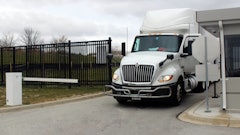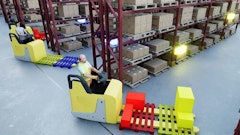Call it the year of supply chain technology. Companies in the retail, food and consumer goods industries are gearing up for major change in 2005 as new technologies take root and become poised for growth. "In the coming year, data synchronization and RFID will continue to present opportunities and challenges for the entire supply chain," predicts Pam Stegeman, vice president of supply chain and technology for the Grocery Manufacturers of America (GMA), Washington.
The same can be said for warehouse management systems with voice technology, real-time supply chain management, system integration and network security. Those are some of the developments to look for and issues to deal with this year, according to top IT executives polled by Food Logistics. They include: Russ Ross, senior vice president, information systems and chief information officer, Giant Eagle, a regional supermarket chain in Pittsburgh; Filippo Passerini, chief information officer, Procter & Gamble Co., the Cincinnati-based consumer products company; Bill Scorse, chief information officer, Banta Foods, a foodservice distributor in Springfield, Mo.; GMA's Stegeman; Mike Heschel, CIO, The Kroger Co., a supermarket chain based in Cincinnati; and Colin Cobain, chief information officer, Tesco, a grocery chain in the United Kingdom.
Here are their forecasts:
Real-Time Visibility Of Inventory, Goods-In-Transit
Russ Ross, senior VP, information services and CIO, Giant Eagle: Consistent with our goal to be the best food retailer, we are dedicated to both streamlining our supply chain operations and enhancing the overall Giant Eagle shopping experience for our customers. Our Supply Chain Excellence program is designed to examine all supply chain functions and identify opportunities to reduce or eliminate operational costs that could be reinvested into the customer value proposition. On the technology spectrum of the supply chain, our decision to implement a warehouse management system from Manhattan Associates, use Vocollect voice technology and formulate an internal working committee to better understand the potential of radio frequency identification are just a few examples of our commitment to remaining an industry leader in innovative supply chain technologies. Ultimately, our major supply chain goals include reducing inventory and shrink, providing real-time supply chain visibility and improving our ability to consistently offer customers food of a quality and freshness level representative of the Giant Eagle brand by limiting out-of-stock scenarios. In 2005, the major supply chain technology hot topics will continue to be real-time visibility of inventory and goods in transit as well as RFID. We have taken major strides to improving our inventory visibility through the implementation of the WMS, and our internal RFID working committee is designed to leverage the business needs and expertise of a cross-functional team in order to more effectively understand the total business and customer-focused implications of using RFID technology.
Collaborative Use Of Technology
Filippo Passerini, CIO, Procter & Gamble: The biggest technology challenge of 2005 is not really a technology challenge at all. It is how manufacturers and retailers of consumer products can more effectively collaborate on the use of technology to better enable our work processes and business strategies. For P&G, that means collaborating with our trading partners on processes that improve the experience of our mutual customer-the shopper. In macro terms, we accomplish this by having the right product in the right place, at the right time and at the right price. If we do this well, then Mr. or Ms. Shopper will reward us both with a purchase. If we don't, then they'll go somewhere else or choose a different product. The business community uses technology to support and enable business strategies and empower consumer choice. P&G resists technology for technology's sake. Looking forward this year, we believe that there are several key strategies that will require the collaborative use of technology.
These include:
Global Data Synchronization: Two trading partners working off the same set of information about a product seems to be an obvious recipe for a successful transaction. The Global Data Synchronization Network (GDSN) is ready for adoption this year. It will improve supply chain execution, get products to the shelf faster and reduce information-related out-of-stocks. It will also help use the emerging Electronic Product Code/RFID Net-work. Inventory, demand visibility and real-time supply chain management: Much like the shopper confronted by an empty store shelf, a manager without real-time information is left frustrated and ill-equipped to fix the issues that face him. Access to real-time information across the supply network delivers value to both manufacturers and customers, and enables issues to be resolved before they affect the store shelf. We will continue to explore ways in which the Electronic Product Code and its associated network can help us deliver this capability.
Standards development: Many of the benefits of using technology need a critical mass of industry adoption before they can be realized. Collaboration in the development and use of standards, for all aspects of information systems, is a contribution to the whole industry and an investment in your own success. These technologies will help us all collaborate more effectively with our trading partners to "Win in the Store." However, they are only a step in the overarching challenge that we face every year: namely, how to collaborate to maximize the value of the shopping experience for consumers, so that they continue to reward us with their business.
Five Challenges Facing The Foodservice Industry
Bill Scorse, CIO, Banta Foods: There are five challenges that we face in the coming year in the information technology field in the foodservice industry: people, system integration, food safety and security, product identification and network security. Let me start with people, our most valuable resource. Without people, nothing will get done. In today's fast-paced, always-on environment, we have to find people that have the quality (education, experience, business knowledge and technical ability) that we need in the food industry to move us forward. In addition to quality, they have to be service-oriented and internally motivated to do what is right for the customer and organization in a timely and accurate manner. In the rapidly changing technology world, they must be able to learn new ways and new technologies and then turn around and apply them to the business and add significant value while doing this. With razor-thin margins in our industry, we have to ensure that the benefits outperform the cost of our resources.
Next, system integration is a key challenge to any distributor, both internally and externally. There are hundreds of software applications available for us to use and improve our business. You only gain the advantage if they are fully integrated into the mix of applications that you have within your organization. As a distributor, you have choices that come your way and you have to decide with whom and how you want to partner for software. We have taken a best-of-breed approach that gives us great depth in each application, but also requires that we fully integrate the application to gain complete advantage of the functionality. This integration also applies to outside partner, both on the purchasing side with vendors, manufactures and re-distributors, and on the customer side with ordering systems integration. I would rate food safety and food security as a challenge to everyone in the food business, not just distribution.
There are so many things that we need to guard against. This area of our business is going to expand and require investment to insure that we can address any concern quickly and accurately. Our industry associations must help us to work with the government to insure that we do what is needed. We must be proactive and efficient in this area.
Product identification and information flow is a challenge that we all face with RFID, EPC, UPC, etc. How will RFID work in foodservice with mixed pallets? Will RFID obsolete UPCs and barcode readers? Will all manufactures embrace RFID, EPC and UPC? How do organizations adopt RFID, EPC and UPCs? One of the most challenging tasks today is network security. We all face security threats every day from internal and external sources. Externally, we face the threat of hackers who want to access our network and steal information or place data farming and pop-up software on end-user workstations. Internally, we face two main threats: one, educating users on viruses and smart computing, and two, teaching good Web practices such as attachments etiquette and staying away from non-legitimate sources. But we also face a challenge from internal hackers. We must ensure that our sensitive information does not leave the company with employees. With the extensive forms of digital media that exist today, diligence is essential to maintaining network security.
Overcoming Data Sync, RFID Hurdles
Pam Stegeman, VP supply chain and technology, GMA: In the coming year, data synchronization and RFID will continue to present opportunities and challenges for the entire supply chain. The benefits have been well documented: increased productivity, reduced costs and improved customer satisfaction. However, to fully achieve those benefits, we still have a number of challenges to overcome.
Data synchronization must continue to be a major focus for our industry. As manufacturers and retailers begin to exchange information automatically, we must ensure that everyone is speaking the same language, using the same terminology and providing accurate data. While global data synchronization (GDS) has addressed the first point by establishing uniform global standards, a communication gap still exists in some areas. Not only must we use the same global language, we must also ensure that we have a consistent definition of even the most basic terminology. We must all have the same understanding of "length," and "width," for example. In addition to ensuring consistent communications, we must also ensure accurate communications. With automatic exchange of data through GDS, it becomes critical for every company to verify the accuracy of the data in their systems before disseminating that data. RFID has several technological hurdles. It is still not proven to deliver acceptable read rates or tag application speeds in a full-production environment, at current manufacturing line speeds, and in highly efficient manufacturing environments. Many of these technological barriers could be worked out on product categories that already have a strong business case for RFID implementation -- pharmaceuticals, for instance.
Finally, we need to remember that RFID is just a tool to improve efficiencies and deliver on consumer needs. We need to define the business processes across the supply chain that can increase our efficiencies and better deliver against consumer needs using RFID as a tool. Then we need to test those new "best practices" to verify their benefits and the role RFID plays in those new processes. GDS and RFID can improve business operations if properly integrated into the supply chain. The technologies will only be successful if the information is accurate, our communications are consistent and supply chain processes are transformed to fully realize the promised benefits. This should be a year to act on the non-technology side of these technologies.
Working With Suppliers To Improve Performance
Mike Heschel, CIO, Kroger: Most of Kroger's thousands of suppliers don't have a clear picture of how they are doing or what is expected in terms of performance, and are therefore lacking a sense of accountability. We have a system in place that penalizes suppliers for missing certain targets, such as on-time delivery, but it doesn't prevent problems. It's also very time consuming to manage. Years of low visibility and poor communication with a large portion of our suppliers have brought average service levels down to an unacceptable level. Because this ultimately impacts customer satisfaction-and Kroger's bottom line-we have changed the paradigm and developed a process for working proactively with suppliers to prevent problems and improve performance on key metrics. The strategy we envisioned includes clearly communicating expectations and sharing performance data with our entire supplier base, and engaging suppliers in collaborative work processes to identify, and avoiding issues before they arise.
Throughout 2005, we're focusing on rolling out an automated and broad-based scorecard reporting and collaboration program to support this process, using GNX's Supplier Performance Manage-ment solution. A key element of success is demonstrating to both internal users and suppliers that the technology and processes will actually improve effectiveness and save time, instead of adding another layer of overhead. And ultimately, it does alter the way Kroger works with suppliers, so we'll be addressing change management issues as well. Additional challenges of this implementation include: Some data is elusive and difficult to get. Other data has only limited usefulness due to faulty measuring points or process limitations. For example, "on time" shipments from the vendor could be considered late due to our delays in the receiving process.















